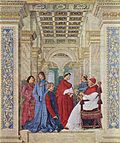Pope Sixtus IV
Pope Sixtus IV (Latin: [Xystus Quartus] Error: {{Lang}}: text has italic markup (help); 21 July 1414 - 12 August 1484),[1] originally Francesco della Rovere, was an Italian priest of the Roman Catholic Church and the 213th Pope from 1471 until his death in 1484.[2]
| Sixtus IV | |
|---|---|
 | |
| Papacy began | 9 August 1471 |
| Papacy ended | 12 August 1484 |
| Predecessor | Pope Paul II |
| Successor | Pope Innocent VIII |
| Personal details | |
| Birth name | Francesco della Rovere |
| Born | 21 July 1414 Celle Ligure |
| Died | 12 August 1484 Rome, Italy |
| Other Popes named Sixtus | |
He is known for beginning construction of the Sistine Chapel.[3]
Early life
Della Rovere was born in Celle Ligure, a town near Savona in Liguria.[3] His family was important.[4]
As a young man, he joined the Franciscan Order. He rose in the order to head of the Franciscans in Liguria.[3]
Della Rovere studied philosophy and theology at the University of Pavia; and he lectured at Padua, Bologna, Pavia, Siena, and Florence.[3]
Cardinal
In 1467, Pope Paul II raised della Rovere to the rank of Cardinal.[3]
Pope
He was elected pope on August 9, 1471.[5] He took the name Sixtus because the first day of the conclave which elected him pope was the Feast Day of St. Sixtus.[6]
Pope Sixtus was involved in Italian and European political disputes.[7]
Papal actions
- 1474 – Christian I of Denmark was received in Rome.[5]
- 1479 – University of Copenhagen established[5]
- 1482 – St Bonaventura was canonized.[5]
Legacy
Sixtus ordered the building of the Ponte Sisto (Sistine Bridge) across the Tiber River.[3]
The Vatican Library was enlarged during the reign of Sixtus; and the number of manuscripts grew ten times larger—from 360 during the reign of Pope Nicholas V to 3650.[8]
Pope Sixtus IV Media
Pope Sixtus IV appoints Platina as Prefect of the Library, by Melozzo da Forlì, accompanied by his relatives
Ponte Sisto, the first bridge built at Rome since the Roman Empire
Tomb monument, by Antonio del Pollaiuolo
Related pages
References
- ↑ Note that the first three popes are called "Xystus" in ancient records. Sixtus or Xystus was a Roman name which was Latinized from the Greek name "Ξυστος." This name means "polished." This name is not to be confused with the common Roman name "Sextus" which means "sixth".
- ↑ "List of Popes," Catholic Encyclopedia (2009); retrieved 2011-11-8.
- ↑ 3.0 3.1 3.2 3.3 3.4 3.5 "Pope Sixtus IV," Catholic Encyclopedia; retrieved 2011-11-8.
- ↑ Sixtus IV was the uncle of Pope Julius II.
- ↑ 5.0 5.1 5.2 5.3 Chisholm, Hugh (1911). The Encyclopædia Britannica: A Dictionary of Arts, Sciences, Literature and General Information. Encyclopædia Britannica Company. p. 164.
- ↑ Guruge, Anura (2010). The Next Pope. Anura Guruge. p. 224. ISBN 978-0-615-35372-2.
- ↑ The Penny Cyclopædia of the Society for the Diffusion of Useful Knowledge. C. Knight. 1842. p. 72.
- ↑ Seldes, George. The Vatican: yesterday, today, tomorrow. Taylor & Francis. p. 30.
Other websites
![]() Media related to Sixtus IV at Wikimedia Commons
Media related to Sixtus IV at Wikimedia Commons
 "Pope Sixtus IV". Catholic Encyclopedia. New York: Robert Appleton Company. 1913.
"Pope Sixtus IV". Catholic Encyclopedia. New York: Robert Appleton Company. 1913.- Catholic Hierarchy, Sixtus IV
- Cardinals of the Holy Roman Church Archived 2011-10-30 at the Wayback Machine, Cardinal della Rovere Archived 2018-01-13 at the Wayback Machine
| Preceded by Paul II |
Pope 1471–1484 |
Succeeded by Innocent VIII |



